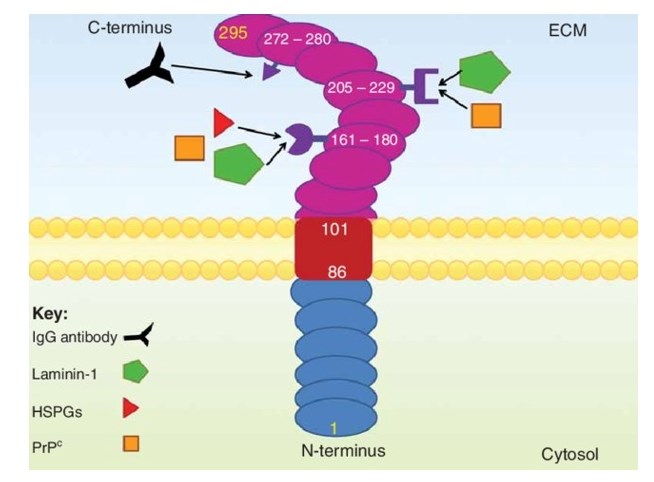What is RPSA Protein
Ribosomal Protein SA, or RPSA, is a multifaceted protein that plays a crucial role in various cellular processes. Also known as 37-kDa laminin receptor precursor (37LRP), this protein is encoded by the RPSA gene. Within the scientific community, it is often referred to by its official full name, "Ribosomal Protein SA," or its alternative names, including LAMR1 (Laminin receptor 1) and LRP/LR (Laminin receptor precursor).
RPSA is a member of the larger 40S ribosomal subunit. Its structural characteristics include a molecular weight of approximately 37 kDa, and it is classified as a ribosomal protein that is vital for the proper functioning of ribosomes—the cellular machinery responsible for protein synthesis.
RPSA Biological Functions and Molecular Mechanisms
RPSA's biological functions are diverse and pivotal for cellular homeostasis. At its core, RPSA primarily acts as a receptor for laminin, a key component of the extracellular matrix. This interaction plays a crucial role in cell adhesion, migration, and differentiation. Moreover, RPSA's involvement in the regulation of ribosomal biogenesis and protein synthesis underscores its significance in cellular proliferation and growth.
Molecular mechanisms governing RPSA's functions include its ability to interact with various molecules, such as integrins and growth factors. These interactions contribute to signal transduction pathways that regulate cellular processes, including cell survival, apoptosis, and cytoskeletal organization. The intricate web of molecular interactions orchestrated by RPSA highlights its versatility in influencing diverse cellular functions.

Figure 1. A schematic representation of the 37/67 kDa laminin receptor. (Jovanovic K, et al., 2015)
RPSA Related Signaling Pathway
The signaling pathways associated with RPSA are intricate and interconnected. RPSA's involvement in the PI3K/Akt and MAPK pathways is particularly noteworthy. Activation of these pathways by RPSA contributes to cell survival, proliferation, and resistance to apoptosis. The cross-talk between RPSA and various signaling molecules underscores its role as a central player in cellular communication networks.
Elucidating the nuances of RPSA-related signal pathways is crucial for unraveling the molecular basis of diseases and devising targeted therapeutic interventions. Researchers are actively exploring these pathways to identify potential drug targets that could modulate RPSA-associated signaling and mitigate pathological conditions..
RPSA Related Diseases
Disruptions in RPSA function have been implicated in various diseases. Notably, aberrant RPSA expression has been observed in cancer, where it can promote tumor progression and metastasis. Studies have demonstrated elevated RPSA levels in different cancer types, linking it to increased cell survival, angiogenesis, and resistance to chemotherapy. The detailed exploration of RPSA's role in cancer pathogenesis is opening new avenues for targeted therapeutic interventions.
Beyond cancer, RPSA dysregulation has been associated with infectious diseases. Its role as a receptor for certain pathogens, including viruses and bacteria, highlights its importance in host-pathogen interactions. Understanding these interactions is crucial for developing strategies to combat infectious diseases effectively.
RPSA's Applications in Biomedicine
The versatile nature of RPSA has sparked interest in its applications in the biomedical field. Researchers are exploring its potential in diagnostics, vaccine development, and therapeutics.
In diagnostics, RPSA is being investigated as a biomarker for various diseases, including cancer. Detecting aberrant RPSA levels in patient samples could serve as an early indicator of disease progression and aid in tailoring personalized treatment strategies.
In vaccine development, RPSA's role as a receptor for pathogens makes it a target for vaccine design. Strategies that target RPSA-pathogen interactions aim to block the entry of pathogens into host cells, providing a potential avenue for developing effective vaccines against infectious diseases.
In therapeutics, efforts are underway to develop drugs that modulate RPSA function. Small molecules and biologics targeting RPSA-associated pathways could offer innovative therapeutic options for conditions ranging from cancer to infectious diseases.
Recommended Products
| Cat.# | Product name | Species | Source (Host) | Tag |
|---|---|---|---|---|
| RPSA-26030TH | Recombinant Human RPSA | Human | Wheat Germ | N/A |
| RPSA-26032TH | Recombinant Human RPSA | Human | Wheat Germ | N/A |
| RPSA-312H | Recombinant Human RPSA Protein, MYC/DDK-tagged, C13 and N15-labeled | Human | HEK293 | C-Myc/DDK |
| RPSA-2508H | Recombinant Human RPSA Protein (2-294 aa), His-tagged | Human | Yeast | His |
| RPSA-2595H | Recombinant Human RPSA Protein (2-295 aa), His-Myc-tagged | Human | E.coli | His/Myc |
| RPSA-447HF | Recombinant Full Length Human RPSA Protein | Human | In Vitro Cell Free System | |
| RPSA-3512H | Recombinant Human RPSA Protein, Myc/DDK-tagged, C13 and N15-labeled | Human | HEK293T | Myc/DDK |
| RPSA-3352H | Recombinant Human RPSA protein, His-tagged | Human | E.coli | His |
| RPSA-2745H | Recombinant Human RPSA Protein (2-295 aa), His-MBP-tagged | Human | Insect Cell | His/Myc |
| RPSA-1474HFL | Recombinant Full Length Human RPSA Protein, C-Flag-tagged | Human | Mammalian cells | Flag |
Reference
- Jovanovic K, et al. Novel patented therapeutic approaches targeting the 37/67 kDa laminin receptor for treatment of cancer and Alzheimer's disease. Expert Opinion on Therapeutic Patents. 2015, 25(5): 567-582.

